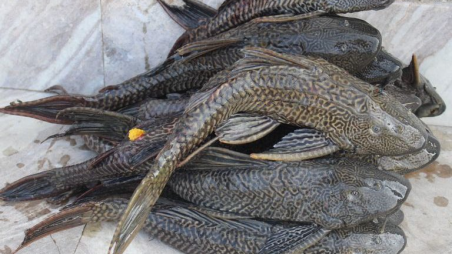The economic potential of the malicious suckermouth catfish
The fisheries and livestock ministry of Bangladesh has banned the breeding, cultivation, conservation and distribution of the ‘malicious’ suckermouth catfish. However, some experts suggest alternative uses to exploit its economic potential

It is not uncommon to spot a pair or more of black armoured fish– known as suckermouth catfish– in aquariums, sticking to the glass and sucking algae. Imported into Bangladesh in the 1980s as both an ornamental and aquarium-cleaning fish, the suckermouth catfish (Hypostomus plecostomus) has now become a serious concern for local fisheries and aquaculture.
It is hard to ascertain how and when this aquarium fish was first released into the natural water bodies of Bangladesh, but it now dominates the breeding grounds of many natural and aquacultured fish. This reality was inevitable as the suckermouth catfish are aggressive invaders and omnivorous fish. As a result, despite originating in northern South America, they are present in at least 17 countries in Europe, the Americas and Asia.
Due to their rapid growth and longevity, suckermouth catfish can rapidly monopolise the nutrient resources of a water body, thus endangering other native fishes. In consideration of the invasive nature of the species, on 11 January this year, the fisheries and livestock ministry of Bangladesh banned the breeding, cultivation, conservation and distribution of the 'malicious' suckermouth catfish.
Will this ban actually help stop the advancement of the 'successful invaders'? The concerned ministry has requested that citizens destroy suckermouth catfish colonies following the motto: 'Kill and bury the carcasses.' It is similar in nature to the way a rat culling programme would operate.
On the other hand, some fisheries experts have suggested more research on the particular species to exploit the economic potential of its alternative usage.

Prior to the ban on the suckermouth catfish, a study was conducted by the Bangladesh Fisheries Research Institute (BFRI). According to the study published on 5 June 2022, this freshwater species can thrive in brackish as well as highly polluted water and have the ability to survive in a hypoxic [not having enough oxygen] condition. This is the reason why suckermouth catfish are found in such abundance in the extremely polluted River Buriganga.
The study also terms the fish species 'malicious' as they alter the aquatic food webs by competing with native fishes and indiscriminately consuming phytoplanktons and zooplanktons. In laboratory tests, 19 types of phytoplanktons and four types of zooplanktons, besides debris, were found in the stomach of the suckermouth catfish.
The fish can grow up to 45cm and weigh around 1500gm with 52-56% flesh. A mature suckermouth catfish in a moisture state contains 20.55-21.22% protein which is 2-4% and 1-2% higher than other carp fish and catfishes respectively. However, excessive cadmium and zinc were found in the fish samples from the Buriganga, the Shitalakshya and a pond in Mymensingh, the BFRI study reads.
Md Anisur Rahman, research lead and director (currently on post-retirement leave) at BFRI, recently told The Business Standard that processed meat of suckermouth catfish could be used as a raw material for animal feed.
"But it requires further research and the raw materials need to be non-toxic," he added.
For the last one and half years, Sher-e-Bangla Agricultural University's Assistant Professor of Fishing and Post-Harvest Technology Md Masud Rana, and his team have been researching the possible growth controlling measures for the 'malicious' suckermouth catfish.
So far, the team's research has found that the dried meat of the suckermouth catfish contains 38% protein. Furthermore, the laboratory samples collected from eight divisions except those of the Buriganga and the Turag, had zero or a less than permissible amount of heavy metals.
"The suckermouth catfish are not poisonous by birth. The meat of the non-toxic fish can be used in the animal feed industry. It will not only meet the local demand, but also create an export opportunity as there is a huge demand for protein-rich feed in the international market," Masud said. He also added that any alternative use of the fish should follow laboratory testing.
Then, what about the 'toxic' fish found in the polluted rivers?

Masud replied, "Globally, the skins and bones of fishes like the suckermouth catfish have been used in decorating leather products like handbags and ready-made garments accessories like buttons. The skins and bones of the toxic fish can be utilised in these ways and the meat can be buried."
Fish skins are often prized in the leather industry for their zigzag texture. Moreover, fish skins require fewer chemicals and less energy to be tanned, as they are usually smaller and thinner than cattle skin. They are relatively stronger due to the crisscrossing structure of the fibres, which make them more elastic and tear-resistant than cowhide.
The researcher explained the necessity of utilising the fish under question in alternative ways. To him, only banning the cultivation and distribution of suckermouth catfish, and destroying their colonies will not work.
"People, specifically fishermen, will not respond to the calls to destroy the colonies if they find no personal gain in the work," Masud said, and recommended controlled value addition to the existing 'malicious' fish and a strict implementation of the ban simultaneously.
The suckermouth catfish are prolific breeders and their hatching success rate is very high. Hence, there needs to be a special programme to control the breeding of the fish in toxic waters like the Buriganga.
"Initially, the regulatory bodies need to identify the full breeding season and the most suitable breeding grounds if they opt for biological control. To implement the 'kill and bury the carcasses' policy along the Buriganga river, the government could announce incentives for the fishermen. Otherwise, controlling the spread of suckermouth catfish will be impossible," Masud concluded.



 Keep updated, follow The Business Standard's Google news channel
Keep updated, follow The Business Standard's Google news channel
















